If you want to make a pizza, you have to use pizza dough. From the perspective of web development, a framework is like the dough. It plays the role of the base of your web application, software, or web service. You have a wide variety of choices and options in making a pizza. In the case of web frameworks that are used to build a web application, the situation is quite the same.
In this article, we will discuss two of the biggest web development frameworks that are used today – Laravel vs Django. We will make a fair and objective comparison of the two. But first, let’s recall the concept of a framework and introduce our competitors.
A framework is a skeleton, and the developers and designers build applications with different features on this skeleton. You can use it as an abstract tool when you need to reuse code or need some help with application development. A framework contains some codes and pre-template structure. The user interface is not necessarily included.
Some frameworks like Django come with an administration interface. But many of the others, the developer will have to write the code, and use it to interact with a variety of framework features. This is an important thing to consider when it comes to choosing the right framework for the project that you are working with. The right framework can help you code easier and faster so you can avoid missing deadlines.
Web development frameworks and their types
The main purpose of web development frameworks is to make the process of web development easier and save the developer time. There are lots of different frameworks available for this service. A large part of backend apps (web apps, web services, and software) are based on frameworks. They can be categorized into two main types:
- Web Application Frameworks - Web application frameworks, or web frameworks, are aimed to help a developer build web-orientated apps, like complex AJAX applications or simple blogs with media galleries, large databases, social-media share buttons, dashboards, menus, etc. It really helps, when it comes to speeding up your work process.
- Software Frameworks - Software frameworks are part of a bigger software framework, where specific functionality is provided by selection and overwriting of the common code that provides common functionality. Such framework contains default behavior, inversion of control, extensibility and non-modifiable code. You are free to use different tools in order to perform specific tasks. Due to this, you can focus on the logic of your application and its original idea and philosophy, without wasting time on routine.
Below, we will compare in more detail the differences between django vs laravel, so you will understand in what areas it is better to apply each of them.
Why a Framework is the Best Solution for Your Business
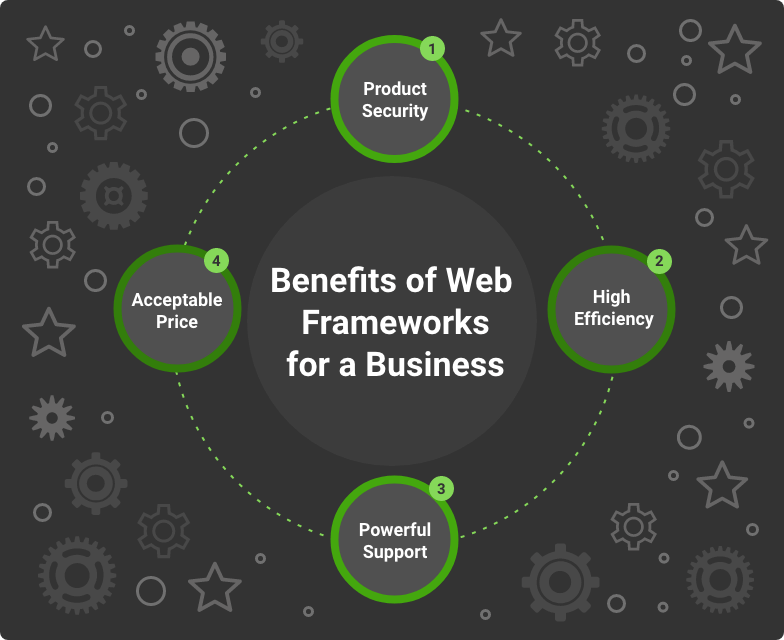
The goal of any business is to release a quality product at a minimum cost. Creating a web site or application can be a complex and time-consuming process depending on the technologies chosen. This is where frameworks come in. They dictate the rules for building software architecture. In turn, product architecture is a set of important decisions about organizing software. Using the framework, you define your project’s structure in advance, which is very important if you plan to develop your software further and add new functions.
By giving preference to a framework, you save coding time, place maximum emphasis on business rules, and reduce development costs. And choosing the right architecture will ensure the longevity of your project. Here are the benefits you can get by using frameworks in web development:
Product Security. The security of your users' data is the highest priority in development and increases confidence in the product. There are many cybercriminals and spyware on the Internet that aim to steal personal information from visitors. The advantage of frameworks is that they have built-in tools to create solid protection for web projects.
High Efficiency. Without frameworks, you have to write all the functionality from scratch. This turns into thousands of lines of code and high development costs. By using a framework, the developers put the product together like a puzzle. What used to take a lot of effort and time to build is now much easier and faster to create using Django or Laravel frameworks.
Powerful Support. The community of both frameworks is highly developed, which means that you always find support for any issue during development. Problems and tasks of any complexity can be easily solved with the help of other coders working with these frameworks. So development delays associated with technical issues are minimized.
Acceptable price. Most frameworks are free. You do not need to pay money to install them since they are open source.
What is PHP framework Laravel?

Laravel is one of the most popular PHP frameworks. It contains many additional libraries that greatly simplify the development process. This framework has detailed documentation and many tutorials, which helps to study it faster. Also, convenient architecture and built-in tools make it attractive for many PHP programmers.
With Laravel, you can simplify your work process and build PHP-based web applications that you want. It clearly follows the model view controller and object-oriented approaches. Because of its useful features, Laravel is one of the most preferred web frameworks in the world.
Companies using Laravel
Since Laravel is well established as a reliable framework for building scalable projects, lots of companies actively used it around the world. Here are some of them:
9GAG. This interactive social network allows users to share memes with total monthly traffic of over 150 million people. The development team uses PHP, Laravel, and Vue.js to successfully cope with the website’s high load.
Pfizer. The website for this large pharmaceutical company that developed an effective vaccine against covid-19 is built with the help of Laravel and AWS. In 2018, Pfizer was ranked 57th in the list of the largest US corporations in total revenue from the Fortune 500.
BBC. This is a national British public broadcasting organization founded in 1922. Their website was created on PHP, in particular on its Laravel framework.
Crowdcube. This platform is designed to help private investors find startups and invest in them. The project is used by over 750,000 investors from all over the world.
TourRadar. This company helps to find and book tours around the world. They offer tens of thousands of different entertainment programs at any time of the year. According to the company's report, they use two PHP frameworks - Symphony and Laravel.
CBS Interactive. This is an online content network for information and entertainment. Its websites cover news, sports, entertainment, technology, and business.
Stitch Labs. The goal of this company is to help brands use their resources efficiently in the development process. The platform aims to empower the operations team to align with marketing, sales, and finance to quickly turn big ideas into action.
Spark Hire. This is a handy video conferencing software. Recruiters worldwide use this product for interviewing candidates.
Paxful. This online platform focuses on selling cryptocurrencies. Using Laravel in its stack, the platform creates a secure environment for the sale of bitcoins and offers over 350 payment models.
GoFundMe. This is a popular American fundraising platform. It allows users to open fundraising events for any situation, from paying for the holidays to difficult life circumstances.
Notable open-source Laravel projects
Due to its stability and security, Laravel is used by large commercial products as well as startups and open-source software. These products make coding a breeze and help to build various platforms from blogs to streaming services.
Cachet - A good choice, if you are looking for a status page system for your website or API.
Invoice Ninja - A good time-tracking, expenses and invoicing app.
Koel - A good instance of personal music streaming server.
Canvas - As a developer, you won’t regret choosing this minimal blogging app.
The framework was released in 2011. And since that time, Laravel has changed a lot. From raw technology, it has evolved into a reliable and affordable programming tool. Let's look at its essential features.
Pros
Growing community
Fast development
Powerful template system
Simple and intuitive routing
Clean architecture
Verified and reliable PHP framework
Cons
Syntaxis is pretty hard for beginners to understand
The indispensable work with standards
Shared hosting is not supported
Does excessive query on databases (for example, if you're using Google Clouds Database, you'll lose some time on it)
Want to build a quality project on Laravel? At KeyUA, we guarantee the best prices and delivery according to deadlines.
Contact UsWhat is Python Framework Django?

Django is a free Python framework that was first released in 2005. It gets its name from guitarist Django Reinhardt. The main goal that the developers pursued when creating this framework is to facilitate the creation of complex websites based on a database. They successfully implemented this idea, and now Django is actively used in many projects involving large volumes of graphic, video, and text content. Python's framework has an MVT (model-view-template) architecture.
No special tools are required to develop a Django project, as the source code can be edited using any regular text editor. However, editors specializing in computer programming can help improve development productivity. Since Django is written in Python, text editors who know about Python syntax are helpful in this regard.
Since 2008, there has been a global Django developer conference called DjangoCon every 6 months. This testifies to the fact that the framework is prevalent and continues to grow in popularity.
Companies who trust Django
This framework is a solid foundation for many web-projects. Big business uses this technology, as well as startups that have gained huge success. Some of them we use every day.
Facebook Inс applies this Python framework in their practice. Thus, one of the most famous social networks, Instagram, is written using Django. This platform has to process large flows of photos, videos and messages daily. And as we can see, Instagram perfectly copes with this thanks to the convenient and reliable Django framework.
Another network for sharing photos also written in Python is Pinterest. It's a strong web project, which is characterized by quick search and convenient data structuring. Django makes it simple and secure.
Many developers use Bitbucket in their practice. This is a solid service launched in 2008, which contains more than 6 million repositories. Atlassian used Python programming language to build their project. And Django allowed them to develop high-quality functionality.
For now, Disqus is the largest of the Django projects. It was created as a startup, but over the years, it has handled the requests of millions of users. With the growth of the project, other programming languages were also applied, but Disqus still uses mostly Django.
Udemy.American’s largest provider of open online courses (MOOC) uses Django tools. The platform was founded in 2010 and even now continues to develop. Udemy has over 35 million users.
Spotify.This is a Swedish internet audio streaming service that allows you to listen to music, audiobooks, and podcasts legally and freely without downloading them to your device. It holds 36% of the global audio streaming market.
The official website of the US National Geographic Society is also built with the help of Django. National Geographic contains interesting and unique content from all over the world and gives access by subscription.
MacArthur Foundation. This is one of the largest charities in the United States. The foundation is active in 60 countries and uses Django as the core technology for its website.
Open Knowledge Foundation. This is a worldwide non-profit network of organizations that promote and distribute information at no cost, including content and data. Founded in 2004, it chose Django years later as its primary technology for building the website.
Mozilla. The company behind this famous browser also uses Django on its website. Mozilla also provides a guide to learning this framework.
Django open source projects
This Python framework is so attractive because it allows developers to quickly and quite easily create a prototype. Lots of open source projects written with this framework have gained huge popularity.
Pinax - Pinax is a convenient project for developers, which combines sites while helping to highlight the differences. It also has a huge base of starter projects and templates, that save time on building prototypes.
NewsBlur - NewsBlur runs as an online RSS newsreader, this website helps to talk about the world. Convenient functionality shows stories you want to read and hides topics you are not interested in.
edX - edX is a popular platform for online learning and provides a lot of useful information on different subjects. Almost all their developed code can be found on GitHub.
Pros and Cons of Django Framework
Many large web projects recognize Django as a successful and effective framework for fulfilling their needs, and its number of fans is growing yearly. This is all due to the following main characteristics.
Pros
- Fast prototyping
- Tons of plugins built over the years
- Great customization
- Solid community support and large documentation
- Data management is simple
- Open-source
Cons
- Can feel bloated from the small project perspective
- You have to be familiar with regular expressions for routing
- Weak templating
- The whole server will restart because of autoreload
The Main Difference Between Django and Laravel
You are probably wondering which is better. But before answering this question, let's compare Django framework vs Laravel framework.
Django | Laravel | |
Technology type | Uses MVT architectural pattern | Uses MVC architectural pattern |
Tools: | It provides many third-party libraries, as well as various decorators and SEO attributes | Provides only a simple set of tools |
Security | Provides a high level of application security | Provides only basic security features and requires third-party solutions |
Development time | Pretty fast | Much slower |
Learning curve: | Easy enough to learn, especially if the developer is already familiar with Python syntax. So, it takes a little time to understand the code | A steep learning curve that takes longer to understand the code |
Routing | Could be difficult as you have to create API by yourself | Quite simple, because it gives an easy way to create an API |
Popularity
The current number of websites that are based on Laravel is 102,048. The market share is 1.32%. At the time of writing this text (May 2018), there were 3,443 websites added and 1,576 websites dropped (or 45.77% of all websites that were added in May).
Update! According to BuiltWith, as of the beginning of 2021, more than 1,213,000 websites are using Laravel as the main framework.
Let's take a look at some charts:
Alexa top 1M

As we can see, Laravel holds the strong 3rd together with Raven.js. AngulerJS and Jquery 2.1.1 are far above the field by a factor of more than 1.5.Let's use our “microscope” and set up our zoom x10:Alexa top 100k According to this cross-section of the top global sites, Laravel feels more confident and follows the top dogs like Vue.js and Express.Let’s take a look at some of Django’s charts:
According to this cross-section of the top global sites, Laravel feels more confident and follows the top dogs like Vue.js and Express.Let’s take a look at some of Django’s charts:
Alexa top 1M

Django is settled just between Vue.js and Laravel.
Alexa top 10k In this sample, Django shows a good result, sharing its position with Vue.js and Express, not far behind Raven.js. Unfortunately, Laravel is not in this top six club.
In this sample, Django shows a good result, sharing its position with Vue.js and Express, not far behind Raven.js. Unfortunately, Laravel is not in this top six club.
What about the freelance market?
| Django | Laravel |
Jobs found | 134 | 143 |
Budget: less than $100 | 32 | 29 |
$100 - $500 | 39 | 57 |
$500 - $1,000 | 21 | 16 |
$1,000 - $5,000 | 31 | 32 |
$5,000 + | 11 | 9 |
Developers found (hourly $) | 13,446 (12,441 independent freelancers \ 1,006 agencies) | 28,542 (24,425 independent freelancers \ 4,120 agencies) |
$10 and below | 2,568 | 7,227 |
$10 - $30 | 58,593 | 15,712 |
$30 - $60 | 18,707 | 4,367 |
$60 & above | 8,755 | 1,238 |
Performance
Python is quite a fast language, that's why Django is considered as a pretty fast framework. Let's look at the benchmarks: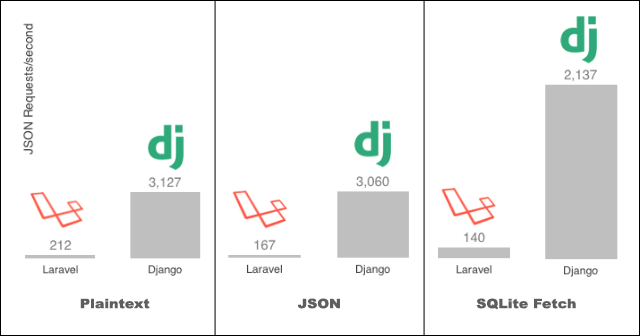 * numbers represented here are requests per second during tests.
* numbers represented here are requests per second during tests.
The following charts consult the next benchmarks: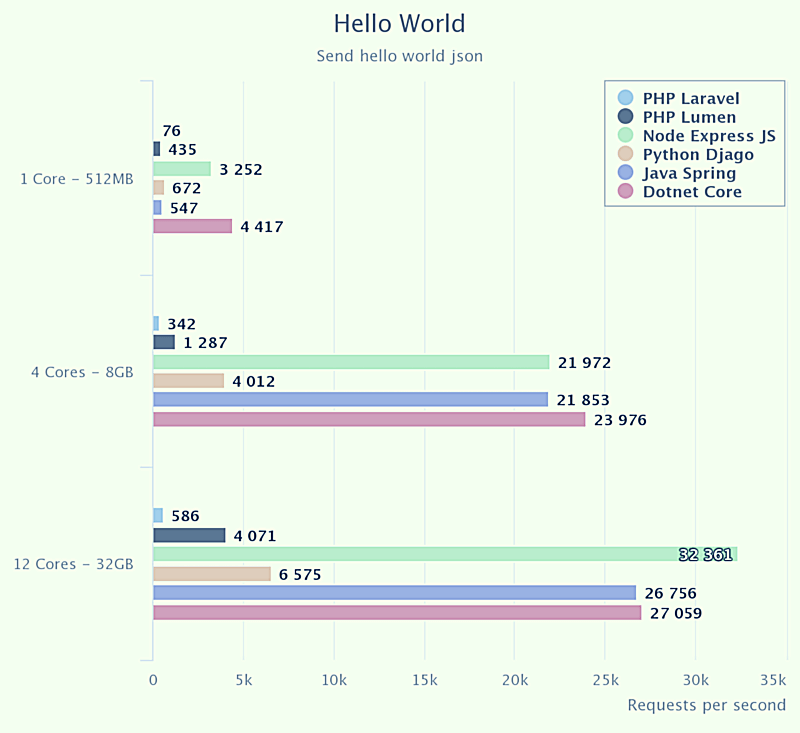
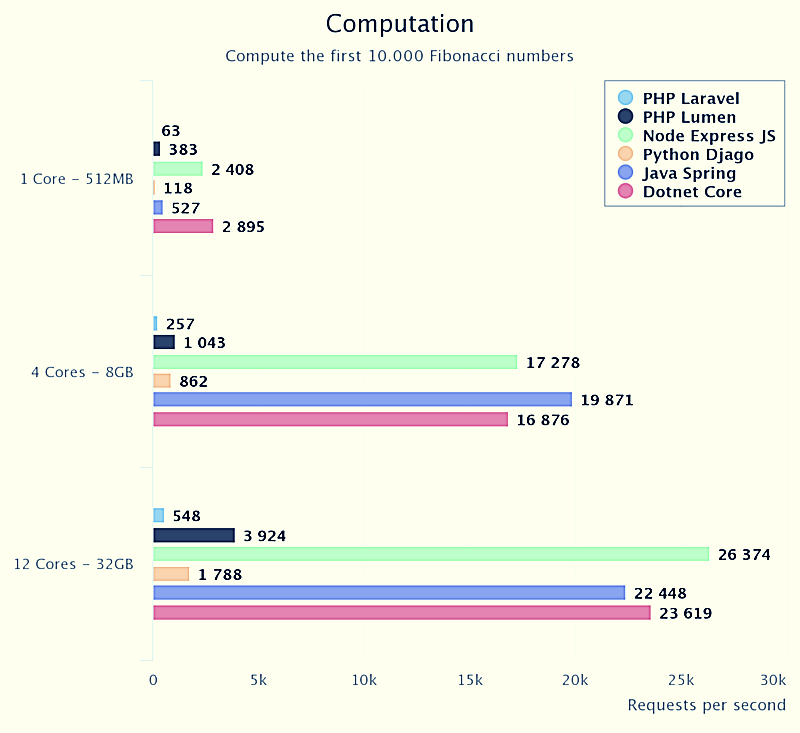 As you can see, Django is pretty fast and demonstrates its speed in each and every test.
As you can see, Django is pretty fast and demonstrates its speed in each and every test.
Want to create a startup or expand your business? It’s easy and affordable with KeyUA. Depending on your needs, we will develop a secure architecture and implement user-friendly functionality.
Get In Touch With UsSecurity
Django vs PHP - Both are widely used software, but like all frameworks, they have their own significant vulnerabilities. Both of these frameworks can be extended with a wide range of app plugins for additional functionality. Despite the fact that Laravel is not that popular in terms of open source projects, Laravel and Django can be attacked from different vectors.
Application layers are the prefered target for hackers, so if you are running full-stack PHP or Python, note that they have their own vulnerabilities, nearly incomparable to other languages and their frameworks.
Let’s take 8 examples for each framework starting with Django!
Django security vulnerabilities
Session Modification. (Django 1.2.7 and 1.3.X until 1.3.1) - Your session details are likely contained in the cache, in this case, root namespacing is simultaneously used by app-data keys and session identifiers. Hackers can modify that session with a key, which is equal to the identifier of your session.
Cache Poisoning (Django 1.4 and 1.5.x (with further exceptions)) - Such penetration can occur if you insert incorrect data into a cache that is related to a DNS resolver. Because of it, nameserver can provide the wrong destination or IP address. Mentioned versions of Django do not include (properly) the Vary: Cookie. It is a cache-control header in your response. Due to this fact, hackers can poison the cache and\or obtain your information.
Session Hijacking (Django 1.4.14, and 1.5.X) - Such an attack allows the attacker to get unauthorized access to your system via session data, related to other users. If users are using contrib.auth.backends.RemoteUserBackend, they can hijack web sessions with ‘REMOTE_USER’ header related vectors.
DoS Attack with Unspecified Vectors (Django 1.8.X +) - DoS stands for Denial of Service. This is when an attacker brings down your website or network by flooding it with data packets. Mentioned versions of Django come with validators.URLValidator that allow a hacker to cause a CPU consumption with unspecified vectors.
Type Conversion Vulnerability. (Django before 1.4.11 and after 1.5.X) - Mentioned versions do not properly perform next type conversions:
GenericIPAdressField
FilePathField
IPAdressField
Due to this fact, attacker can get access to unspecified vectors that are related to MySQL.Arbitrary URL Generation (Django 1.3.X +) - Because of a function called django.http.HttpRequest.get_host, hackers can display and generate arbitrary URLs using crafted passwords and usernames.
Directory Traversal (Django 1.1.X, 1.2.X) - A weakness in these versions allows hackers to read and\or execute with a ‘/’ character in a session code’s cookie that is related to session replays.
CSRF: Forged Requests (Django 1.2.7, 1.3.X, except 1.3.1) - This attack forces the browser to perform any action on another site where the user is signed in. These versions of Django come with a weak CSRF protection. This protection doesn’t handle server configurations properly, so remote attackers can trigger forged requests by a web page, which contains JS code and vectors, including DNS CHAME record.
Laravel security vulnerabilities
1. file_get_contents() - With this simple function, an intruder can get content of your file:
However, if attacker wants to go further, he can get file names from the server:
With this function, an intruder can read files from the server and get its content.
It’s quite difficult to detect this vulnerability, so be careful!
2. Double form submission - Your PHP script can be executed twice because of double-click on the submit button. Needless to say that it can result in big problems.
3. File upload into public_html - Basically, intruder can upload executable file (.php, for example) into public_html. Let’s leave possible consequences on your imagination.
4. ZIP bomb - There are websites, where you can upload .zip archives, then you can extract it and do whatever you want with those files. The trick is that you basically can upload archive that takes only 40 KB, which grows up to 4506742 GB of space. Sounds like a nuclear explosion inside your server, right?
5. CSRF - Just like Django, Laravel has some weak points when it comes to cross site request forgery. Image a picture that there is a link on the website, with which user can remove his account, like so:
Now imagine that a hacker posts some comment on the website… like so:
If user clicks the link, he’ll delete his own account.
6. ClickJacking - This one is aimed to make user click where he definitely don’t want. Like the invisible Twitter retweet button just on top of “login” button.
Opening Twitter in <iframe> and connecting it with JavaScript would result in a user retweeting someone’s Twitter account every time they click anywhere on the page.
7. Injected SQL - This is the most famous vulnerability. A hacker can input his own SQL right into your code. If you have something like:
If anyone enter this into email field: 1 OR 1, the query will change and look like this:
In other words, we just deleted each and every post for each and every user.
8. Cross Site Scripting - This kind of looks like a previous section. You can inject JS\HTML code into HTML page. For example, if we look at the search engine page (like Bing or Google), the result page will show what you are looking for:
If hacker enters this:
JavaScript will run by user’s browser, and he’ll see the popup message saying “hey, look at that!”. So what? Hacker can steal your password, cookies, or redirect you to other website.
Both Django and Laravel have their own security issues, but it is possible to protect your website in the best way possible. Safety first!
Learning Curve
In the case of Laravel and Django, it may be difficult to understand which one is easier to start with. Let’s try to sort out the features that play a central role.
Templating is pretty simple with these frameworks, due to the fact that both of them provide well-made templating engines.
Routing is an important aspect that is provided by backend frameworks. In the case of Django, it can be pretty hard, as you have to learn about regular expressions. With Laravel, you can simplify your work with routing. Let's take a look at simple examples:
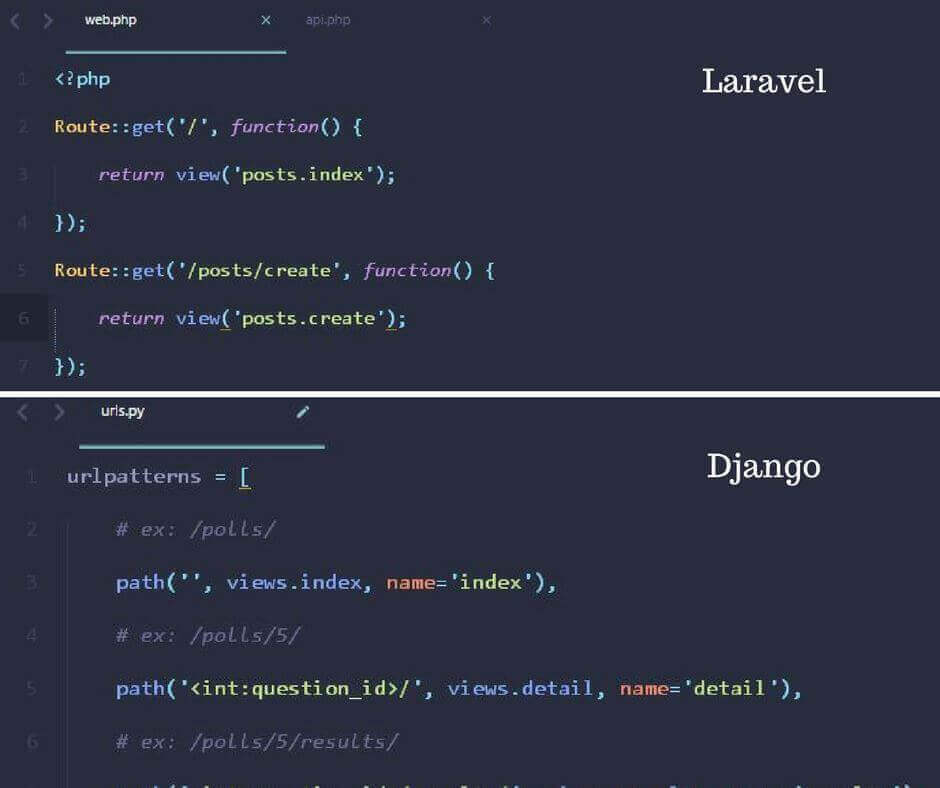
You can use Laravel to create an API in a simple way. It returns JSON format for any database query. Furthermore, developers can separate their API endpoints if they place the routes in another file, which is provided by Laravel.
With Django, you have to use REST framework if you want to work with structures that allow you to create an API.
The project structure is well-made in both Django and Laravel, with one small exception - Django offers you separate directories for your applications, which is not provided by Laravel.
Features
As was mentioned in the previous section, it can be difficult to create APIs with Django. But, you are free to use its built-in decorators, such as has_permission, require_POST, and login_required. Another feature is the admin application that allows the user to build a site area in automatic mode, as well as view, create, delete or modify current records. This may help you speed up your development!
Laravel comes with an elegant ORM (object-oriented mapper). It also has a neat bundle modular packaging system and different dependencies. These will help you modify and update your applications, especially when it comes to Laravel 3.
Conclusion
In this article, we reviewed the main advantages and disadvantages of Php vs Python. We learned that Django helps developers create and launch their platform quickly, without the mess. It is well-secured and protects from SQL injections, clickjacking, cross-site scripting, etc. Additionally, this language is compatible with major OS and databases, making it easy to work with a couple of DBs at the same time.
When choosing between laravel or django, we always lean in favor of the Python framework. This technology has already established itself as a qualitatively reliable background for many successful projects. If you compare the total number of sites written in Laravel and Django, the second framework is used by twice as many online platforms.
We write in various frameworks, but Django is our favorite. It enables us to create high-quality applications and web platforms. As a result, we have earned lots of satisfied customers and users around the world. We use Django because we care about the safety of personal data and the rapid delivery of the project.
Looking for trusted and advanced web developers? At KeyUA, we implement ideas of any complexity.
Contact Us







 Unit 1505 124 City Road, London, United Kingdom, EC1V 2NX
Unit 1505 124 City Road, London, United Kingdom, EC1V 2NX

Comments
Leave a comment